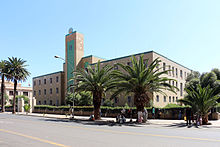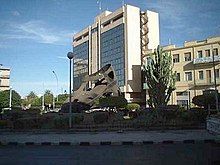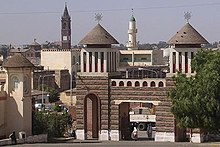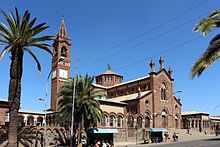Eritrea
Eritrea, officially the State of Eritrea (in Tigrinya: Hagere Ertra; in Arabic: دولة إرتريا, Dawlat Irītriyā; in Italian: Stato dell'Eritrea), is a country located in northeast Africa. It borders to the north and west with Sudan; to the south with Ethiopia and Djibouti; the east of the country has a long coastline with the Red Sea. Also part of Eritrea are the Dahlak Islands, a coral archipelago off the coast of Massawa. Its name comes from the former Italian colony Eritrea, created on January 1 from 1890, named after the Mare Erythraeum ("Red Sea", in Latin) in turn from the Greek "erythros", which means "red". it became independent in 1993 from Ethiopia. Its capital and most populous city is Asmara.
The kingdom of Aksum, which encompassed much of what constitutes Eritrea and northern Ethiopia, arose around the 1st century or II and adopted Christianity shortly after the emergence of this religion. In medieval times much of Eritrea remained under the rule of the Medri Bahri kingdom, a part forms the Republic of Hamasien.
In the XVI the Ottomans conquer parts of Eritrean territory. In the XIX Egypt invades parts of Eritrea. The creation of modern Eritrea is the result of the incorporation of independent kingdoms and various vassal states of the Ethiopian Empire and the Ottoman Empire, that gave rise to the formation of Italian Eritrea. In 1885 Italian troops arrived in Eritrean territory and on January 1, 1890, Italy officially declared its conquered territory a colony of its own.
In 1941 Eritrea was conquered by the British Empire as part of the East African campaign. In 1952 it was annexed to the Ethiopian Empire to form the Federation of Ethiopia and Eritrea. This forced union would give rise to the Eritrean war of independence, which concluded with the independence of present-day Eritrea in 1993.
Eritrea is a one-party state where national elections have been repeatedly postponed. According to Human Rights Watch, the Eritrean government's human rights record is considered among the worst in the world. Military service is compulsory from 17 years to 50 years of age and although the law dictates that recruitment is 18 months, the army and the country's authorities arbitrarily extend the period indefinitely and indefinitely, which causes some Eritreans flee the country. Since all local media outlets are state-owned, Eritrea also ranked as having the lowest press freedom in the world press freedom index, except for Turkmenistan and North Korea.
History
Portuguese Empire
Portugal, on its way to find the kingdom of Prester John ("Preste João" in Portuguese), a crucial ally in attacking Mecca, discovered that it would have to dominate the Red Sea. To this end, used its navy as a platform to attack the Ottoman Empire, but it would be necessary to create trade and supply bases. The Portuguese with their missionaries also sought to consolidate religious power.
The presence was possible in Massaua and Arquico, the latter being a small village south of the port of Massaua, governed by the Portuguese captain Gonçalo Ferreira, to guarantee the presence of a second port for the maintenance of the Portuguese fleets.
In the port of Massaua it was planned to build a fortress by order of King Manuel I, a project that was abandoned after his death. Despite this, in 1541 Massaua and its port were designed by João de Castro, who gave an exhaustive description of the city.
The coast of present-day Eritrea was the one that guaranteed the connection with the Tigré region, where the Portuguese had a small colony and, therefore, the connection with the Ethiopian interior, allies of the Portuguese. Massaua was also the scene of the landing of Cristóvão da Gama's troops in the military campaign that would finally defeat Adal in the decisive battle of Wayna Daga.
Italian Colony
Throughout history and until 1890, the year in which Italy colonized the territory and officially delimited it, the area of Eritrea had been part of various empires and kingdoms in the region. The Kingdom of Italy, after the Treaty of Wichale, created the colony of Eritrea in 1890 and maintained it until World War II, with the same borders it has today.
With the aim of establishing their own domain over these lands, the Italians brought great development to Italian Eritrea, from agriculture to basic industries, including infrastructure. Asmara, the capital of the country, was the theater of an architectural development (mainly in the art deco style) that is still admired worldwide today. By 1940 there were about 100,000 Italian settlers in Eritrea, which had repercussions on the architecture of some of its cities and on the religion of its inhabitants.
Decolonization
In 1941 Eritrea was conquered by the British during World War II and became part of the British colonial administration. In 1952 it federated with Ethiopia, until in 1962 the union dissolved and Eritrea was downgraded to a province.
The Eritrean resistance then acted against Ethiopia, leading to various conflicts that turned into open warfare in 1983. After four years, and now under the control of the Popular Front for the Liberation of Eritrea, the People's Democratic Republic of Ethiopia once again declared Eritrea in 1987 as an autonomous region.
In 1993, after three decades of national liberation war, the independence of Eritrea was internationally recognized. However, that did not prevent subsequent territorial conflicts with Yemen in 1996 and war with Ethiopia again between 1997 and 2000.
The intervention of the UN and the definitive establishment of borders in April 2002, by resolution of the International Court of Justice, temporarily stopped the war, but Ethiopia has not yet accepted the resolution presented by the International Court of Justice. Therefore, the work of delimiting the border is not finished and the threat of war between the two countries still persists.
Politics
Following the referendum of April 1993, Eritrea declared itself an independent state. Once a Transition Government was established, the governing and administrative bodies were formed, which were subsequently modified according to the following structure:
- The Advisory Council, later converted into a Council of State, formed as a Council of Ministers plus territorial representatives.
- The National Assembly as the legislative branch of the FLPE Central Committee, 30 provincial representatives and 30 representatives of FLPE, and then 5 representatives of FLPE and 75 others elected by the provinces.
- The judiciary.
Human Rights
In terms of human rights, regarding membership of the seven bodies of the International Bill of Human Rights, which include the Human Rights Committee (HRC), Eritrea has signed or ratified:
Eritrea is a one-party state where national legislative elections have been postponed several times, and its human rights record is considered one of the worst in the world. Since Eritrea's conflict with Ethiopia in 1998- Since 2001, Eritrea's human rights record has worsened. According to these reports, alleged human rights violations are systematically committed by the Eritrean government. Similarly, according to these reports, the freedoms of expression, press, assembly and association are limited. Those who practice unregistered religions, try to flee the country, or escape military service, are arrested and imprisoned in oppressive conditions, and sometimes allegedly tortured to "force them to renounce their faith." National and international human rights organizations are not allowed to operate in Eritrea.
The registered religions, based on the Eritrean census, are the Eritrean Orthodox Church (an Eastern Orthodox denomination), the Eritrean Catholic Church, the Eritrean Lutheran Church, and Sunni Islam. All other religions are persecuted, including other denominations of Islam, such as Shiism, and other denominations of Christianity, such as any of the myriad Protestant denominations and Jehovah's Witnesses. Denominations of Christianity were not given freedom of worship until 2002, when the government banned worship and gatherings outside of "registered" religions. All groups that meet secretly for worship in a house or any other unregistered place are arrested and imprisoned. According to various NGOs, religious freedom is one of the main reasons why thousands of Eritreans flee the country. There are thousands of Eritrean refugees in Ethiopia and Sudan seeking asylum in Europe or other Western regions.
In 2014, Eritrea's four Catholic bishops took the risky step of criticizing living conditions in the country, calling them "desolate," and calling for "humane treatment of detainees& #34;.
Administrative divisions
The country is made up of six administrative regions, further subdivided into provinces and local entities. The six regions of Eritrea are as follows:
- Anseba
- Central
- Gash-Barka
- North Red Sea
- South
- Southern Red Sea
Geography
Eritrea is located in eastern Africa, specifically in the region known as the Horn of Africa. It is practically crossed by the Great Rift Valley, a very long tectonic fault; this area is fertile, but as you go west the terrain becomes desert. In the north of the country there is an extension of the Ethiopian massif, with heights that reach 2,600 meters and where large tropical rainfall occurs. This region is bounded by the Barka, Gash and Anseba rivers. The northeast, for its part, is made up of a very dry plain.
The coastal strip of mainland Eritrea faces the Red Sea and is 1,151 km long. Annual highs of 50 °C are reached in this region. The country also has islands in the Red Sea whose coastlines stretch for 1,083 km. The southern highlands of Eritrea are drier and cooler than the rest of the country. The Dahlak Islands are located a few kilometers from the coast and their waters are rich in fishing. In Eritrea is the Danakil desert and the Kobar depression, located 130 meters below sea level.
Ecology
The predominant biomes in Eritrea are savannah in the interior and desert on the coast. The WWF divides the territory of Eritrea into seven ecoregions, from west to east.
It is located in the extreme southeast of the country, on the border with Ethiopia and Sudan. It occupies an area of 917,600 square kilometers. It is bordered to the north by the acacia savannas of the Sahel, to the east by the Ethiopian montane forest, to the southeast by the mosaic of forest and savannah of the Lake Victoria basin, the Kenyan bush savannah, the East African montane forest and with the montane jungle of the Albertine fault; to the south with the jungle-savanna mosaic of northern Congo, to the west with the western Sudanese savannah and to the northwest with the Mandara massif mosaic.
The flora is dominated by combretum and terminalia trees and shrubs, and the high sericure species pennisetum purpureum. The animals that predominate in this region are: the African elephant (loxodonta africana), the wild dog (lycaon pictus), the cheetah (acinonyx jubatus) and the leopard (panthera pardus). Black and white rhinos were native inhabitants of this region, but have disappeared.
Sahelian acacia savannah
It is located in the west of the country. The predominant vegetation is the wooded savannah. The most common tree species is the acacia. The fauna is poor due to indiscriminate hunting. It is bordered to the north by the southern Saharan steppe and bushveld and various enclaves of the western Sahara xeric forest, to the northwest by the Atlantic coastal desert and the northern Sahara steppe, to the northeast by the Red Sea coastal desert, to the southwest by the western Sudanese savanna, to the south by the Mandara massif mosaic, to the southeast by eastern Sudanese savannah and Saharan floodplain, and to the east by Ethiopian montane rainforest, Somali bush savannah, and xeric grassland and scrubland Ethiopia.
Ethiopian montane rainforest
It is found in the north, in the extension of the Ethiopian massif, between 1,100 and 1,800 m above sea level. Several plant communities can be distinguished in this zone: Kolla (low altitude open forest, dominated by terminalia, commiphora, boswellia and acacia) weyna dega (in higher and more humid areas, it is dominated by conifers), and the rest is called shrubby forest. There is a large number of mammals.
Ethiopian Montane Grassland and High Forest
It is located in the Ethiopian massif, above 1800 m above sea level. Its natural vegetation is made up of closed forests in the humid areas and scrubland in the drier areas, but very little remains of this original vegetation. The scrubland areas abound with Podocarpus falcatus and Juniperus procera. Most of the region's fauna is adapted to the cold climate of the mountains. It is located in a narrow strip to the east of the Ethiopian massif. It occupies an area of more than 1 million square kilometers.
Ethiopian Xeric Grassland and Shrubland
It is found on the eastern coast of Eritrea. It occupies an area of 152,000 square kilometers.
Eritrean coastal desert
It is situated in the extreme southeast, on the coast of the Bab-el-Mandeb Strait, off the coasts of Yemen and Saudi Arabia. It is a desert ecoregion that occupies an area of 4,400 square kilometers, stretching from Balfair Assoli, in Eritrea, to Ras Bir, in Djibouti.
Economy
After independence in 1993, Eritrea maintained a subsistence economy similar to that of many other African countries, with close to 80% of the population engaged in agriculture and livestock, aggravated by successive conflicts with Ethiopia.
After the 2000 offensive, Eritrea recorded losses worth more than 825 million dollars, with serious damage to the agricultural sector, maintaining a decline in its economy for three years.
After the conflict, and thanks to government intervention, important improvements have been achieved in ports, airports and road communications, although it is still a long way from achieving a significant drop in the unemployment rate and stabilizing the economy in order to improve the living conditions of the country. However, Eritrea has a strategic trading position in the Red Sea and its mineral reserves of marble, granite, silver, copper, zinc, gold and silica are very important.
Demographics
Eritrea has 6,147,398 inhabitants, 800,000 of whom live in the capital Asmara. Other important populations are Assab (100,000 inhabitants), Keren, (70,000 inhabitants), Mendefera with 68,000 and Massawa (important port and former capital of the country) with 37,000.
There are nine ethnic groups in Eritrea: the Afar, the Bilen, the Beja (the Hedareb), the Kunama, the Nara, the Rashaida, the Saho, the Tigré and the Tigrinya.
Languages
Today many languages are spoken in Eritrea, although there are none that have official status as such, since the Constitution establishes the equality of "all the languages of Eritrea". However, Tigrinya and Arabic are the two predominant languages for official purposes. English and Italian are also used, due to the colonial past. Most of the languages spoken in Eritrea derive from the Semitic and Cushitic branches of the Afro-Asiatic language family. The Semitic languages in Eritrea are Tigrean, Tigrinya, the newly recognized Dahlik, and Arabic (natively spoken by Rashaida Arabs); those languages (mainly Tigre and Tigrinya) are spoken as mother tongue by more than 80% of the population. The Cushitic languages in Eritrea are very numerous, including Afar, Beja, Blin and Saho. The Kunama and Nara languages are also spoken in Eritrea and belong to the Nilo-Saharan language family.
Religion
Eritrea has two predominant religions: Christianity, with 62.9% adherents; and Islam, which groups 36.2% of the population. Christians mainly belong to the Eritrean Orthodox Church, which is a patriarchate of the Coptic Church and accounts for 57.7% of the population, while there is also a considerable number of Catholics (belonging to the Eritrean Catholic Church, a Catholicism of oriental rite representing 4.6% of the population). Protestantism and other registered Christian denominations such as Seventh-day Adventists make up 0.7% of the population. Most Muslims follow the Sunni branch of Islam.
Since May 2002, the Eritrean government has officially recognized the Eritrean Catholic Church, the Eritrean Coptic Church, Sunni Islam, and the Evangelical Lutheran Church. All other religions and denominations are required to undergo a registration process. Among other things, the government registration system requires religious groups to submit personal information about their members in order to be allowed to operate in the country. The few organizations that have met all of the registration requirements have yet to receive official recognition.
Jehovah's Witnesses, Baha'is, and many denominations of Protestant Christianity are not registered and cannot operate freely in the country. When Eritrea became an independent state in 1993, Jehovah's Witnesses lost their fundamental freedoms such as finishing their education, having their own business, or leaving the country. By decree of October 25, 1994, President Isaías Afewerki withdrew their citizenship. Witnesses for not voting in the 1993 referendum on independence and for objecting to military service. Since then, the authorities have imprisoned, tortured, and persecuted Jehovah's Witnesses with the intent of forcing them to renounce their faith.
Health
The fertility rate in Eritrea is approximately 5 births per woman. One of the main causes of newborn deaths is severe infections. Malaria and tuberculosis are common in Eritrea. The prevalence of HIV among the 15-49 age group exceeds 2%. In 2002, only 28% of births were attended by specialized health personnel. Per capita spending on health is low in Eritrea. In the last decade of the 20th century, maternal mortality has decreased considerably.
Education
There are five levels of education in Eritrea: pre-school, primary, middle, secondary and post-secondary. There are about 238,000 students in primary, middle, and secondary education. There are approximately 824 schools in Eritrea and two universities (Asmara University and the Institute of Science and Technology), as well as several smaller universities and technical schools.
One of the most important goals of Eritrea's education policy is to provide basic education in each of Eritrea's mother tongues, as well as the development of a self-motivated and conscientious population to combat poverty and disease. Furthermore, it aims to provide the equipment to produce a society that is endowed with the necessary skills to function in the modern economy.
The education system in Eritrea is also designed to promote private sector schooling, equal access for all groups (i.e. to avoid gender discrimination, ethnic discrimination and class discrimination) and promote continuing education, both formal and informal.
Education in Eritrea includes kindergartens for children of both sexes.
Culture
Eritrea is a multilingual country. Most of the languages spoken there come from two large families, Semitic and Cushitic. The Semitic languages of Eritrea are Arabic (natively spoken by the Rashaid ethnic group), Tigrinya, Tigre, and Dahlik. Among them, Tigrinya and Tigre are the first language for around 80% of the country's population. The Kushite languages of Eritrea are numerous, including Afar, Beya, Blin, and Saho. Kunama and Nara, two languages belonging to the Nilo-Saharan family of languages, are also spoken. English is used to a greater degree in education, and Italian is also an important language.
Eritrean cuisine has certain similarities to those of Ethiopia and the Middle East due to its geographical location.
Sports
Athletics is important in the country, with specialists in long-distance running such as Zersenay Tadesse, who was the only Eritrean athlete to win a bronze medal at the 2004 Athens Olympics. Ghirmay Ghebreslassie was champion of the World Marathon in Beijing 2015.
Cycling has a great fan base. This sport was introduced by the Italian colonizers. There are many races throughout the country, and several of the best Eritrean cyclists compete professionally in UCI ProTeam teams. Daniel Teklehaymanot was the winner of the African Road Championships and time trial. Other outstanding cyclists are Natnael Berhane, Mekseb Debesay, Amanuel Ghebreigzabhier and Merhawi Kudus and the winner of a stage of the Giro d'Italia (stage 10) Biniam Girmay.
Contenido relacionado
Paris
6th century
History of oceania













